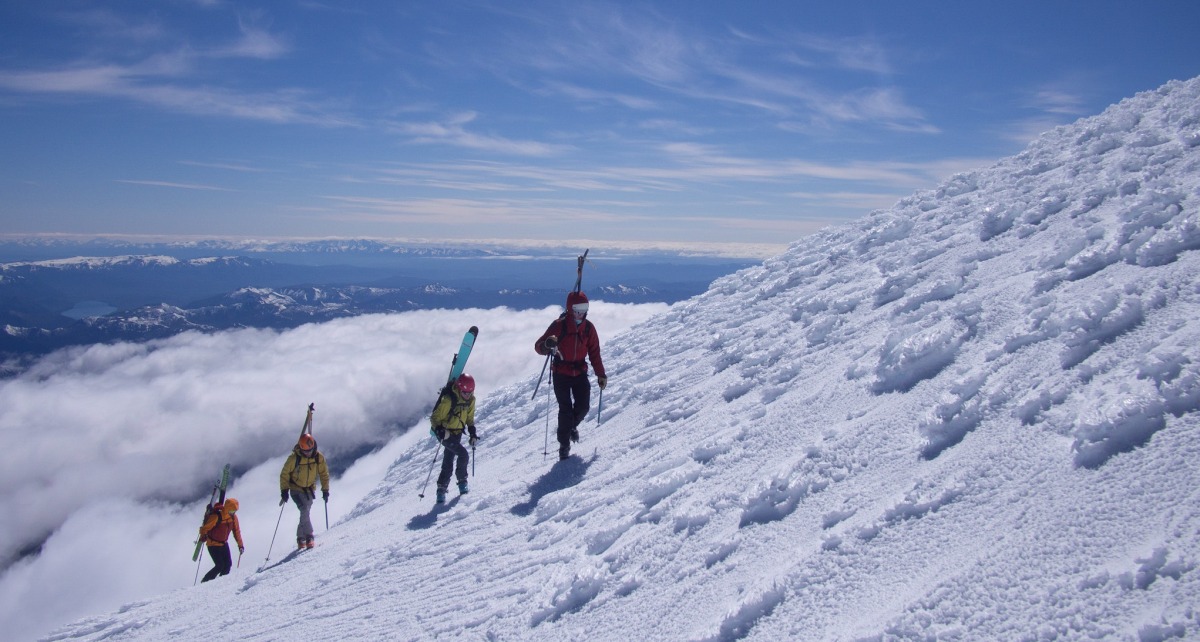
Ten days prior to this photo, none of the skiers involved had skied in this part of this country. Some of the pictured skiers had never skinned. The team had excellent leadership, grew together, got a handle on local conditions, and then pushed it together to “on sight” this 8000 foot climb and descent of Volcan Lanin on the Chile/Argentina border. Photo: Jed Porter
Use conditions, terrain and group dynamics to step it up
There you are, facing that inspiring, but daunting, list of awesome things you wish to do in the backcountry (don’t have such a list? Here’s one.) Each objective in your sights requires that you grow, at least to some degree, as a backcountry skier. How the heck do you organize that path forward? You can, of course, throw figurative darts and hope your path takes you to the radness. Or you can map out your big picture route, much like you will map out the crevassed approach to the line of your dreams. “The journey is the destination” but the destination informs the journey.
If you wish to move forward with some structure, consider the following framework for stepping up your ski mountaineering ambitions and objectives.
The variables that affect our safety and success in backcountry adventures can be divided into a few simple categories. In every adventure, there are knowns and unknowns. We walk a ‘risk and reward’ tightrope. We go for the adventure, but we need to come home too. There will always be danger in the mountains. Whether from the conditions, the terrain, or from our own inexperience, we face hazards. In seeking to balance the adventure and risk against safety and sustainability, there are pluses and minuses; things that work for you and things that work against you, in terms of your exposure to hazard. When evaluating the potential for epicness and unepicness, consider how these particular things balance out:
Familiarity with the conditions.
Familiarity with the terrain.
Competence of partners and yourself.
Too many “minuses” in these categories is a recipe for disaster. A real solid plus in one category can mitigate minor debits in the others. A real significant debt in one or more category, however, cannot be overcome with any sort of positives in the others.
Try this checklist as both a planning tool and as a debriefing exercise:
Right now, think back to some adventures, both epic and smooth. Is there a pattern? Likely those trips that turned rough had a fair amount of minuses in these categories. And the clean trips will have a clear net positive. In looking ahead, and in seeking more of the kinds of endeavors that gently push that boat out, make sure the pluses outweigh the minuses in terms of conditions, terrain, and group dynamics.
I can offer no “quantitative” tool for assessing the pluses and minuses on this three-point scoring system, but I can suggest some further examples.
At either end of the spectrum, the examples are easy:
Brand new to the backcountry, and therefore unfamiliar with both the terrain and conditions? You absolutely need to go out with a partner or team that is fully dialed in both their own skills and in the skills associated with instructing and managing the safety of another.
Have a team of truly experienced, competent, well-trained backcountry travelers? You can go almost anywhere given enough planning and patience. The catch is that rank beginner status is thankfully short-lived, and actually assembling a truly competent, truly experienced team is as rare as it is beautiful. You won’t always need the oversight of a guide, but you can’t always go out with folks ready for 16000 foot Alaskan peaks. “In between” is where the art of using my bulleted mental model above comes into play.
Consider these examples and hypotheticals:
You’ve skied with your competent buddies for a few seasons. They’ve now wandered on to raise kids or play hockey. You’re the strong one, but unaccustomed to that role. To start, go to familiar zones and known runs, in familiar conditions, with your new circle of lesser experienced partners.
You want to ski the legendary steeps (and inherently unfamiliar terrain and conditions) of Thompson Pass, Alaska? Take a partner or partners that are ready to crush.
What if you are the so-called “weak link”? You have a group of friends that is more accomplished and dialed than you, or so you think. They want to take you to their favorite terrain, in conditions you imagine they are familiar with. How do you verify your assumption that they actually know what’s up? Flashy Instagram presence and high “season-days” counts are just one part of the equation. In my last WildSnow post I elaborated in greater detail on how to “screen” the leader of your initial backcountry forays.
Decision-making in avalanche country is a fluid, amorphous thing. We battle our own limitations and fickle mountain conditions in a quixotic pursuit of wild, athletic perfection. To organize our thoughts and stack the odds in our favor, break it all down into manageable bites. Look at each trip, past, present, and future, and ask questions in these three categories. How familiar are we with these conditions? How confident am I of what this terrain actually looks like? What is the group’s experience and competency level? Make sure the pluses outweigh the minuses, and drop in heavy!
Jed Porter is a passionate adventure skier and all-around mountain professional. His primary work is as a mountain guide, skiing and climbing all over the Americas and beyond. Learn more about him at his website linked below.
